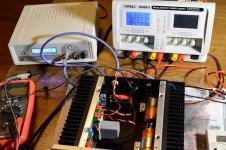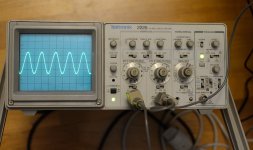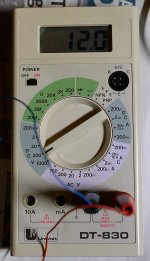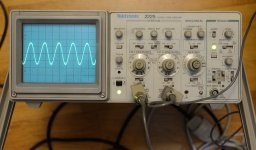Thanks for the replies. I am using ~16 ohm speakers of average efficiency, no balanced source, so unbalanced bridged would be the configuration of most interest to me. (My current 3.5W amp is not quite up to the task, but come close). Probably showing my ignorance here, but what diminishes some of the "audio goodness" in bridged mode, the effective addition of another stage?
........My question is the R12 68.1K ohm 0.4W resistor in the PCB 1B now. . In order to use the new power units for the mono blocks they recommend to reduce the value of the resistor to 39.2 K ohm. I imagine it would be 0.4 watts like the 68.1K in there now, is this correct? I just don't want to screw anything up replacing the R12 with an incorrect wattage for the 39.2 resistor. When I went on to the Digi-Key site there were all types of 39.2 K resistors with different watts. Thanks for any help from this newbie...
0.4w is fine.
A good rule of thumb for anything like this is to look at the maximum supply voltage available. The resistor can not ever see more than that voltage under any condition, normal operation or fault condition.
Your 39.2k @ 0.4w part could handle up to 125 volts across it before the 0.4w dissipation point was reached. So absolutely no problem in the ACA where the dissipation will be of the order of a few milliwatts.
4 OHMS 24V SUPPLY 5W
There will be some full curves for you soon.....
I bought a pair of ACA v1.6 and intend to run them as balanced monoblocks. The literature says 15-20W assuming its into 8 ohms. Will the kit work into 4 ohm loads? Only asking because my 92db efficient speaker is 4 ohm.
I bought a pair of ACA v1.6 and intend to run them as balanced monoblocks. The literature says 15-20W assuming its into 8 ohms. Will the kit work into 4 ohm loads? Only asking because my 92db efficient speaker is 4 ohm.
It pushes my ESS speakers around with authority.. you won't be disappointed! A watt is incredibly strong. Hope this helps!
i am sorry if this is noob question; I have looked everywhere and can't figure it out. Now that I have an ACA power amp and am building a B1 pre-amp, there are a few features from my integrated amp that I am trying to replicate. I currently have two RCA line outs that i use for my tape deck to record and for my sonos connect to play in other rooms. How do I get similar functionality from these separate amp and pre-amps? Can I add similar "line out" connections?
thank you Chris! would you believe it, i finally found it (been looking for days). Here it is in case anyone else is looking for it: B1 builders thread
It pushes my ESS speakers around with authority.. you won't be disappointed! A watt is incredibly strong. Hope this helps!
Ok thanks. My speaker choices sorted by sensitivity are:
Martin Logan Motion 40 4 ohm 92 db
Polk Audio RT55 8 ohm 91 db
Polk Audio T15 8 ohm 89 db
Polk Audio LSiM707 8 ohm 88 db
Totem Hawk 6 ohm 88 db
Polk Audio LSi25 4 ohm 88 db
KEF Q100 8 ohm 86 db
I’m going to guess RT55 would be best choice since it’s 8 ohms and OK on sensitivity. Others either have too low a sensitivity or impedance. And from specs I read, lower impedance shows lower power than 8 or 16 ohm speakers.
Ok thanks. My speaker choices sorted by sensitivity are:
Martin Logan Motion 40 4 ohm 92 db
Polk Audio RT55 8 ohm 91 db
Polk Audio T15 8 ohm 89 db
Polk Audio LSiM707 8 ohm 88 db
Totem Hawk 6 ohm 88 db
Polk Audio LSi25 4 ohm 88 db
KEF Q100 8 ohm 86 db
I’m going to guess RT55 would be best choice since it’s 8 ohms and OK on sensitivity. Others either have too low a sensitivity or impedance. And from specs I read, lower impedance shows lower power than 8 or 16 ohm speakers.
Impressive selection. Try them all - will be curious which one you choose!
Do you have actual impedance curves? The nominal impedance is only a very loose number.
Is the Martin Logan an ESL? Being a capacitor an ESL needs an amp with high current capability.
dave
No, they are not electrostatic, the Motion series uses traditional drivers. ACA not a high current amp means I should go at least 8 ohm and high sensitivity.
I have KEF Q100 coaxial speakers, cheap tweaked by me (the sound is much better than the originals).
Impedance and phase:

Frequency and dispersion:

The problem is the true sensibility is between 84 - 85 dB. If you listen music with low DR, nearfield and in phase... but the ACA has few watts!
Pro-Audio and lighting Calculators. Calculator page
Impedance and phase:

Frequency and dispersion:

The problem is the true sensibility is between 84 - 85 dB. If you listen music with low DR, nearfield and in phase... but the ACA has few watts!
You can estimate the SPL at your distance.14 dB of voltage gain and 5 watts of output
Pro-Audio and lighting Calculators. Calculator page
I don't know if I am more jealous of all your speaker choices, or having all the equipment to actually measure them!  My dad is an electronics engineer (retired) and he says that when his oscilloscope died, it was like loosing an arm and an eye.
My dad is an electronics engineer (retired) and he says that when his oscilloscope died, it was like loosing an arm and an eye.
I'm going to have to cope with just the multimeter. I guess that is enough for the ACA, right? Best regards,
Rafa.
I'm going to have to cope with just the multimeter. I guess that is enough for the ACA, right? Best regards,
Rafa.
I see the dampening factor as 0.7 for 4 ohms. That implies output impedance is over 5 ohms. Bridged is double that.
The open loop of the ACA is very high, and the damping factor is very low.
Virtually of the damping comes from feedback, and that figure is 10 for
8 ohms, 5 for 4 ohms. It degrades slightly at 10 Hz, but .7 @ 4 ohms
does not match a -.5dB @ 10 Hz frequency response figure.
The damping factor is 10 at higher frequencies, and this is an .8 ohm
output impedance. -.5 dB occurs at 1.35 ohms, which would give us a
dF of 6 at 10 Hz. 3 at 4 ohms.
I made my first measurements on one of my ACAs. I used a lab PSU set to 24V and I was able to set the "bias" to 12V. I use 121k and 33.2k as NFB resistors (to get higher input impedance). This is a factor 3.6 vs 3.9 if 39.2 and 10k was used. So I have a little less gain. With 1.9VAC in I measure 5.2 VAC out over a 8.2 ohm resistor. Think this makes sense (8.7 dB gain)?
The oscilloscope picture I think was a 10kHz sinus (5V pr. div).
At 20 kHz with 5.2 V (RMS) out (8.2 ohm) I can see small artifacts on the sinus. If I reduce the input signal a bit it looks better. Is that expected?
When the amp was cold I think the bias current was 1.45A but when it is warm the current is only 1.26A. Does this make sense? ....it was when the amp was loaded (5.2 V / 8.2 ohm). My generator can't output more than the 1.9V RMS so don't know when it clips.
Maybe I should change the 33.2k NFB resistor (R11) to a smaller value to have a little more gain....so it is closer to the 10 dB.
One negative side with the physical large input cap is that it can pick up noise. If I touch it with one hand the 50 Hz field gets into the amp. The larger value NFB resistors I use probably also makes the input circuit a bit more noise sensitive. But I think with the top cover on there is no problem.
At least the amp seems to work!
Maybe I will need an active preamp........instead of the passive I use in the moment.
The oscilloscope picture I think was a 10kHz sinus (5V pr. div).
At 20 kHz with 5.2 V (RMS) out (8.2 ohm) I can see small artifacts on the sinus. If I reduce the input signal a bit it looks better. Is that expected?
When the amp was cold I think the bias current was 1.45A but when it is warm the current is only 1.26A. Does this make sense? ....it was when the amp was loaded (5.2 V / 8.2 ohm). My generator can't output more than the 1.9V RMS so don't know when it clips.
Maybe I should change the 33.2k NFB resistor (R11) to a smaller value to have a little more gain....so it is closer to the 10 dB.
One negative side with the physical large input cap is that it can pick up noise. If I touch it with one hand the 50 Hz field gets into the amp. The larger value NFB resistors I use probably also makes the input circuit a bit more noise sensitive. But I think with the top cover on there is no problem.
At least the amp seems to work!
Maybe I will need an active preamp........instead of the passive I use in the moment.
Attachments
Attached picture shows a 250 kHz sine (2V / div).
At reduced output level it looks good.
This was just to have some fun trying to provoke the amp.......
Strange things happens if I increase the input level. Bias current goes down.....but amp seems robust......
At reduced output level it looks good.
This was just to have some fun trying to provoke the amp.......
Strange things happens if I increase the input level. Bias current goes down.....but amp seems robust......
Attachments
- Home
- Amplifiers
- Pass Labs
- Amp Camp Amp - ACA



